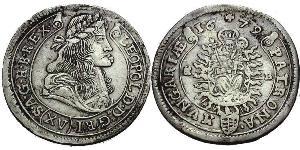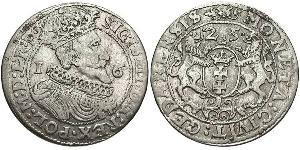(sold for $44.0)
Mint Year: 1696 Mint Place: Emden Denomination: 6 Stuber (Schilling) Reference: Knyph. 6549, KM-110. Condition: Weakly struck area due to a shallow planchet, otherwise a nicely toned VF+ Diameter: 30mm Weight: 4.05gm Material: Silver
Obverse: Crowned and composite coat-of-arms, flanked by mint master´s initials (*FB-*P). Legend: . CHRISTIAN . EBERHARD . P . & . D . F . O . D . E . S .& . W Reverse: Crown above double headed eagle. Titles of Emperor Leopold I "the Hogmouth" around. Legend: LEOPOLD . D . G . ROM IMPER . SEM . ANG . 1696
Emden is a town and seaport in Lower Saxony in the northwest of Germany, on the river Ems. It is the main town of the region of East Frisia and, in 2011, had a total population of 51,528. The exact founding date of Emden is unknown, but it has existed at least since the 8th century. Older names for Emden are Amuthon, Embda, Emda, and Embden. Town privilege and the town's coat of arms, the Engelke up de Muer (The Little Angel on the Wall) was granted by Emperor Maximilian I in 1495. In the 16th century, Emden briefly became an important centre for the Protestant Reformation under the rule of Countess Anna von Oldenburg who was determined to find a religious "third way" between Lutheranism and Catholicism. In 1542 she invited the Polish noble John Laski (or Joahannes a Lasco) to become pastor of a Protestant church at Emden; :xi and for 7 years he continued to spread the new religion around the area of East Frisia. However, in 1549 following pressure from the Emperor Charles V, the Countess was forced to ask Laski to leave for England and the experiment came to an end. Nevertheless, the legacy was important for the reformation in the Netherlands. Emden was a very rich town during the 17th century, due to large numbers of Dutch immigrants such as Diederik Jansz. Graeff. It was a centre of reformed Protestantism at that time, producing the first Bible translation in Dutch. The Emden Revolution in 1595 resulted in Emden becoming a distinct city-state. The political theorist Johannes Althusius served as Syndic from 1604 to 1638. :xii In 1744 Emden was annexed by Prussia. In 1752 Frederick the Great chartered the Emden Company to trade with Canton, but the company was ruined when Emden was captured by French forces in 1757 during the Seven Years' War. The town was recaptured by Anglo-German forces in 1758 and for the rest of the conflict was used as a major supply base by the British to support the ongoing war in Westphalia. During the Napoleonic French era, Emden and the surrounding lands of East Frisia were part of the short-lived Kingdom of Holland. Industrialization started at around 1870, with a paper mill and a somewhat bigger shipyard. At the end of the 19th century, a big canal, the Dortmund-Ems Canal was constructed, which connected Emden with the Ruhr area. This made Emden the "seaport of the Ruhr area", which lasted until the 1970s. Coal from the south was transported to the North Sea port, and imported iron ore was shipped via the canal towards Rhine and the Ruhr. The last iron ore freighter was moored in the port of Emden in 1986. In 1903, a large shipyard (Nordseewerke, "North Sea Works") was founded which still exists today.
Prince Christian Everhard of East Frisia (1 October 1665, Esens – 30 June 1708, Aurich) was a Prince of East Frisia from the House of Cirksena from the day he was born in 1665, but remained under guardianship until 1690.
Before taking office, he had spent much time abroad. Unlike some other members of the Cirksena family, he had few disputes with the Estates of East Frisia. He took over government in 1690 from his mother, who had administered the country until then as his guardian and regent. He quickly settled some disputes with the Estates and thus consolidated the peace. This gave him his nickname "the peaceable".
Christian Everhard was considered prudent, tolerant, and pious. Like his mother, he allowed the presence of the Reformed Church, although he himself was Lutheran. He agreed an inheritance treaty with the Guelph elector Ernest Augustus of Brunswick-Lüneburg. However, the Emperor rejected this treaty, so it never came into force. Instead, the Emperor accepted a claim by Brandenburg and ruled that if the Cirksena family were to die out, Brandenburg would inherit East Frisia. Based on this ruling, Prussia occupied East Frisia when the Cirksena died out in 1744.
Christian Everhard had always been sickly since childhood, and was therefore always accompanied on his travels by his personal physician, Eberhard Bacmeister. He died at a young age, like many Cirksena. He died in 1708 and was succeeded by his second son George Albert.
Only 1$ shipping for each additional item purchased!

|
Posted by:
anonymous 2018-05-23 |
8 Real Viceroyalty of the Río de la Plata (1776 - 1814) / Bo ...
group has 26 coins / 23 prices
⇑
















_Bolivia-300-150-KkcKbzbiaxIAAAFLUI3k0KhM.jpg)






